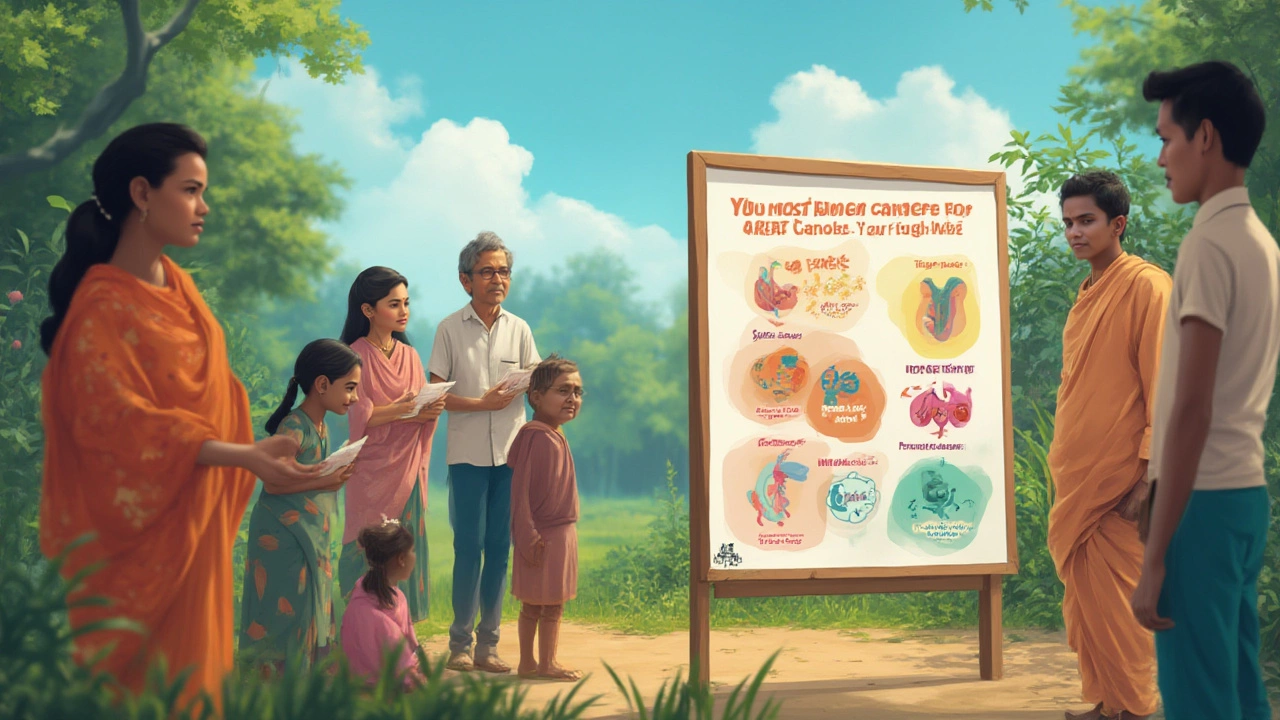Sit with anyone diagnosed with cancer, and the fear is obvious. But not all cancers mean the same fight. Here’s a wild fact: the difference between surviving one type of cancer versus another is huge—sometimes as wide as 98% vs. 10%. So what is the easiest cancer to survive, and what makes it beatable? Doctors and researchers actually track this stuff very closely, down to the decimal. Some cancers are far more forgiving than others. And the reasons behind this aren’t as mysterious as you might expect. A couple types stand out way above the rest—let’s break down exactly why, look at real numbers, and figure out what puts the odds in your favor.
Why Survival Rates Differ: Behind the Numbers
The reason one cancer is less deadly often comes down to a few key factors: where it starts, how fast it grows, and how easily it’s spotted early. Most people assume all cancer is one big, unpredictable monster, but that’s far from true. Some cancers stay local for years, rarely spreading. Others almost never show up until they’re everywhere. Early diagnosis heavily tips the scale—for example, almost everyone survives skin cancer when it’s caught soon.
If you want proof that early is everything, look at melanoma—a dangerous form of skin cancer. Diagnosed before it spreads, the five-year survival rate jumps to over 99%. That’s about as close as you get to a sure thing in medicine. Compare that to pancreatic cancer. It stays hidden until late, and only about 12% of people survive even five years after diagnosis.
Certain places in the body just cause less trouble. For example, thyroid cancer often grows slowly and responds well to treatment. That’s why its five-year survival rate is an eye-popping 98%. Dr. Emily Wu, a top endocrinologist, says, "The thyroid is easy to monitor using ultrasound, surgery is low risk, and even if the cancer returns, it’s rarely life-threatening." She’s not exaggerating: people walk out of surgery and live regular lives. It’s one of the few cancers where patients sometimes don’t even need aggressive therapy.
Beyond location, there’s also the factor of how good treatments are for certain cancers. Some, like testicular cancer, have advanced so much that even late stages get cured more often than not. Chemotherapy for testicular cancer (especially for the kind called seminoma) is super effective. Testicular cancer mostly strikes young men, but the prognosis is so strong it almost doesn’t matter when it’s found.
Even for so-called “easy” cancers, outcomes depend on age, genetics, lifestyle, and access to good doctors. But across continents and age groups, these truths hold. Curious how these cancers stack up? Check out the numbers in the table below, using recent data from the American Cancer Society and European registries.
| Cancer Type | Five-Year Survival Rate (%) | Common Age at Diagnosis | Main Treatment |
|---|---|---|---|
| Thyroid Cancer | 98 | 20-55 | Surgery |
| Testicular Cancer | 95 | 15-35 | Surgery, chemotherapy |
| Skin Cancer (Melanoma - Localized) | 99 | 20-49 | Surgery |
| Prostate Cancer | 97 | 65+ | Surgery, radiation |
| Pancreatic Cancer | 12 | 65+ | Surgery, chemotherapy |
Notice the shocking gap. A person with thyroid cancer or early melanoma is in a totally different league compared to someone with pancreatic cancer. The best survival bets are clear. The trick is getting diagnosed before cancer spreads. That one factor—stage at diagnosis—can be the whole game.
One major reason survival is so high for the easiest cancers: symptoms show up early and can be spotted fast. A lump under the skin, a mole that looks odd, or a swelling in the neck is hard to ignore. Want a tip? If anything changes in your skin or testicles, see a doctor—the earlier, the better your odds.
Let’s keep breaking this down for each cancer type, looking at warning signs and best shot at beating it.

Easiest Cancers to Survive: Case by Case
Let’s start with thyroid cancer. Truth is, people often find out they have it by accident—like through a scan for something else. It rarely causes symptoms early on. When it does show up, it’s a painless lump or swelling at the base of the neck. Treatment? Nearly always surgery and, sometimes, a little radioactive iodine. Rarely do doctors need to go nuclear with chemotherapy.
Here’s an interesting note: researchers in Korea studied over 400,000 cases. More than 95% of patients were alive a decade after being diagnosed. That’s why some doctors are even debating if small thyroid cancers need any immediate treatment at all. It’s not just about surviving—but surviving well.
Next up, testicular cancer. It’s an "outlier" in the cancer world because it hits young men. Survival rates have exploded in the last 50 years, mostly because of breakthroughs in chemotherapy. Most guys notice a lump or swelling, sometimes a weird ache, and walk into a clinic. Surgery usually takes care of it; chemo is a backup plan if it spreads. You might be surprised to hear that famous cyclist Lance Armstrong survived advanced testicular cancer that had spread to his brain and lungs. He was totally cancer free after treatment (and, well, that’s before we get to the doping stuff…).
Skin cancer, specifically melanoma, has become a public health campaign all by itself. Think of all the sunscreen ads, or your dermatologist cousin nagging you about that strange patch. With over 100,000 cases each year in the U.S. alone (and way more of the common "non-melanoma" types), the upside is almost every early melanoma gets removed and never comes back. That’s why the secret is paying attention. The ABCDE rule—Asymmetry, Border, Color, Diameter, Evolving—is a catchy trick to spot a dangerous spot on your skin before it spreads. Early stage means nearly everyone survives five years or more.
Don’t forget prostate cancer. It mainly shows up in older men, usually after 60. While it can be serious if caught late, the majority of prostate cancers grow slowly—often so slowly they’ll never cause harm. In fact, a big Scandinavian study found that watching and waiting (“active surveillance”) works for many, sparing men from tough side effects. With surgery or radiation, the five-year survival rate in most developed countries clocks in around 97%.
Of course, no cancer is "easy" emotionally. Even the most survivable types bring worry and life changes. But statistically, the cancers above have odds that are the envy of anyone with a tougher diagnosis.
Still, no matter how promising the numbers, the fastest way to stack the odds on your side is early detection. Cancer agents and advocacy groups push for regular screenings: self-exam for testicular cancer, annual skin checks for anyone with lots of moles, or PSA blood tests for older men worried about prostate cancer. Here are some quick, research-backed tips to boost your chances:
- Check your skin each month—even ask a friend or partner to look at your back or scalp.
- Any lump, bump, or new spot that didn’t go away in a week? Get it checked.
- If you’re a guy under 40, do a monthly testicular self-exam in the shower. Doctors say it works best when the scrotum is relaxed.
- If your family has a history of cancer (especially at a young age), talk to your doctor about starting checkups earlier than the standard guidelines.
- Don’t ignore a persistent cough, hoarse voice, or blood in your pee—it sounds obvious, but millions of people brush these off every year.
It’s easy to tune out the flood of health advice, but this is one area where 10 minutes could save your life. And that’s not just some cliché. Studies from the UK, Australia, and Japan back it up: the countries with public awareness programs see earlier diagnosis, fewer deaths, and lower medical costs for the "easier" cancers.

Tips for Lowering Your Risk and Catching Cancer Early
Here’s where small tweaks can really help. Most "easy" cancers have risk factors you can lower, often without extreme effort. Sunlight drives almost all skin cancer. If you love being outside, do it! But throw on a hat and sunscreen, and skip tanning beds. One 2023 Australian study—the country with the world’s highest skin cancer rates—found that daily sunscreen cut melanoma risk in half for regular people.
Testicular cancer isn’t much about lifestyle, but awareness matters. Young men usually don’t talk about this stuff, but the quicker a lump gets checked, the fewer need chemo or advanced treatments. Some colleges actually hand out how-to cards for monthly self-checks in student welcome bags—sounds cheesy, but it works.
For thyroid and prostate cancer, genetics and age play a big role. You can’t change your DNA, but regular checkups and being aware of symptoms is huge. Family history is an underrated tip-off. If someone in your family has had any "easy" cancer, flag it to your doctor—screenings might start 5-10 years earlier.
An underrated weapon in the fight: diet and exercise. There’s tons of evidence now that people who stay active and eat mostly plants (think veggies, whole grains, healthy fats) seem to have lower rates of almost every cancer. For prostate cancer, some newer studies point to lower red meat and dairy consumption as lowering risk, but the science is still early. What’s not debatable? If you smoke, quit today. That idea isn’t just for lung cancer; smoking makes a bunch of other cancers more aggressive or harder to treat.
Want a checklist for catching these cancers early?
- Monthly skin self-exam: Check for any weird spots, colors, or changes.
- Testicular self-exam: Roll each testicle gently. Any lump, size change, or hardness? Get it checked right away.
- Neck check: While looking in a mirror, swallow water and watch for lumps popping out in your neck (especially near your Adam’s apple). That’s where the thyroid sits.
- Annual physical: Mention any family cancer history. It updates your risk profile for thyroid, prostate, and more.
- Healthy habits: Sunscreen, no smoking, lots of plants in your meals, and regular exercise. Nothing wild, but it has a huge impact long-term.
Here’s a wild stat: almost 40% of Americans will get some form of cancer in their lifetimes. But for the “easy to survive” types, most will live full, normal lives after treatment—if they get checked and act fast on anything odd.
Last thing—don’t let statistics lull you into ignoring symptoms. Even “simple” cancers need fast attention. Survival rates are just that: averages. There are always outliers, and the sooner something is found, the more likely you’ll be part of the 99% club. Think of your monthly skin self-exam or doctor’s visit less like a chore and more like personal insurance that doesn’t cost you a dime.
The bottom line: Among all the types out there, skin cancer (especially early-stage melanoma), thyroid cancer, testicular cancer, and prostate cancer are the “easiest” to survive, thanks to early warning signs and effective treatments. But catching anything late puts you right back in dangerous territory. So, notice changes. Don’t delay. Your chances are better than you think when you act early—sometimes as high as 99%.
